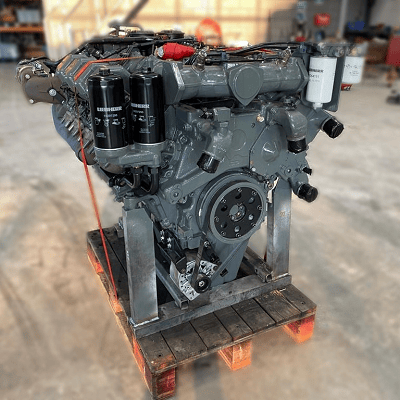The process of a dyno test on a Liebherr engine

When it comes to heavy machinery, reliability and power are paramount. Liebherr, a name synonymous with innovation and excellence in engineering, stands tall as a pioneer in the realm of heavy equipment and machinery. From towering cranes to robust excavators, Liebherr’s engineering prowess extends to the heart of these machines. We delve into the world of dyno testing a Liebherr engine, uncovering the meticulous process behind unleashing the raw power concealed within.
The foundation of excellence
Before we embark on the journey of dyno testing, it’s crucial to understand the foundation upon which Liebherr engines are built. With decades of engineering expertise and commitment to quality, Liebherr engines are crafted to withstand the most demanding environment and deliver unparalleled performance. Each component is meticulously designed and rigorously tested to ensure reliability, efficiency and longevity.
The process
1 Preparation: The engine undergoes meticulous preparation before being mounted onto the dynamo meter. This includes ensuring all connections are secure, fluids are filled to the appropriate levels, and sensors are properly calibrated.
2 Mounting: The engine is carefully mounted onto the dynamometer, a specialized device designed to simulate real-world operating conditions. Precision is paramount during this step to ensure accurate results.
3 Initial checks: Once mounted, a series of initial checks are conducted to verify proper alignment, connection integrity, and functionality of all engine systems.
4 Warm-up: The engine is started and allowed to warm up to operating temperature. This ensures consistent results and minimizes the risk of damage during testing.
5 Baseline testing: With the engine warmed up , baseline tests are conducted to establish initial performance metrics. This includes measuring power output, torque, fuel consumption, and emissions at various RPM levels.
6 Load testing: The engine is subjected to progressively increasing loads to simulate different operating conditions, such as idle, partial load and full load. This allows engineers to assess performance across the entire operating range and identify any potential issues or optimization.
7 Data analysis: Throughout the testing process, data is continuously collected and analyzed in real-time. Advanced instrumentation and software are used to monitor performance metrics and identify trends or anomalies.
8 Optimazation: Based on the data analysis, adjustments may be made to optimize engine performance. This could involve fine-tuning fuel injection timing, adjusting air-fuel ratios, or optimize turbocharger boost pressure.
9 Validation: Once testing is complete, the results are meticulously reviewed and validated against predetermined criteria and specifications. Any deviations or anomalies are thoroughly investigated to ensure accuracy and reliability.
10 Reporting: Finally, a comprehensive report is generated detailing the results of the dyno testing, including performance metrics, observations, and any recommendations for further optimization or refinement.
The outcome of dyno testing
Dyno testing a Liebherr engine is more than just a routine procedure – it’s a testament to the unwavering commitment to excellence that defines Liebherr’s engineering philosophy. By subjecting their engines to rigorous testing and analysis, Liebherr ensures that each engine delivers the uncompromising performance, reliability, and efficiency that customers expect.
In conclusion, dyno testing a Liebherr engine is not just about measuring power output. It’s about unlocking the true potential of these remarkable engines and ensuring they exceed expectations in the most challenging environments imaginable.
Automatic transmission fluid (ATF) is a type of hydraulic fluid used in vehicles with automatic transmissions. It is typically coloured red or green to distinguish it from motor oil and other fluids in the vehicle.
Atf Oil is generally replaced every 120,000 kilometers, and the severe driving conditions are replaced every 60,000 kilometers.
Atf Transmission Fluid must meet the following requirements when working in an automatic transmission:
a) The efficiency of transfer power is related to the viscosity and degree of foaming. Therefore, the viscosity and degree of foaming are required.
b) When ATF works in an automatic transmission, the internal operating temperature of the system can reach -40-170 ° C, the oil flow rate can reach 20m/s, and it is continuously contacting with non-ferrous metals and air, so the oil antioxidant performance is high.
c) When ATF works in the system, the friction and other friction of the bearing and gears in the system must also be lubricated with ATF, so the ATF should have a certain lubrication performance.
d) With the advancement of modern automatic transmission technology, its overall size continues to shrink, but at the same time, it must ensure that its speed and transmission power remain unchanged. Therefore, the larger the ATF proportion.
Automatic Transmission Fluid is developed specifically to meet the requirements of high -performance automatic transmissions. It is suitable for all automatic transmission that requires using the dexrin II specifications.
This product can also be widely used in occasions that require hydraulic transmission, including power steering mechanisms, hydraulic systems, etc., and are not suitable for the DEXRIN VI specifications.
1.Excellent high temperature and stability, prevent oxidation of oil oxidation and the production of sediments, and keep the gearbox clean.
2.Good anti -abrasion protection effects, effectively extend the service life of parts.
3.Improve the friction characteristics and ensure that the gearbox is sustainable and reliable.
4.Good stability, shifting is smoother.
Auto Transmission Fluid,ATF Oil,ATF Oil Transmission,ATF Transmission Fluid
Guangzhou Lidi Automobile Supplies Co., Ltd. , https://www.lambosscn.com